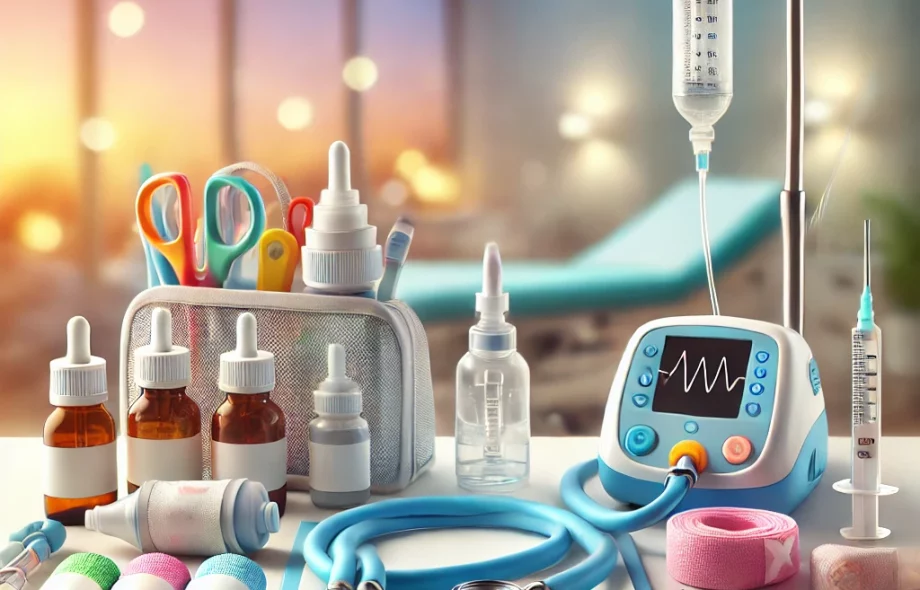As a pediatric care provider—whether you’re a doctor, nurse, or parent—having the best pediatrics medical supplies on hand is crucial for delivering safe, effective, and compassionate care. Children aren’t just small adults; they need specialized tools designed for their unique needs.
In this guide, we’ll walk you through the must-have pediatrics medical supplies that ensure accurate diagnoses, effective treatments, and a comforting experience for little patients.
1. Essential Medical Equipment for Pediatric Care
A. Diagnostic Tools
When it comes to assessing a child’s health, precision matters. Here are the best pediatrics medical supplies for accurate diagnostics:
Pediatric Stethoscope – A smaller chest piece is essential for clear heart and lung sounds in infants and toddlers. Brands like Littmann offer child-friendly designs.
Digital Thermometer – Fast, reliable readings are a must. Forehead or ear thermometers (like Braun ThermoScan) are less invasive for kids.
Pulse Oximeter – A pediatric pulse ox with soft sensors (such as Masimo MightySat) ensures accurate oxygen monitoring without discomfort.
Blood Pressure Cuff – Standard cuffs won’t fit tiny arms. Look for child-sized BP cuffs with clear markers.
Otoscope & Ophthalmoscope – A quality set (like Welch Allyn) helps examine ears and eyes safely.
B. Emergency & Treatment Supplies
Kids can be accident-prone, so having the right best pediatrics medical supplies for emergencies is non-negotiable:
Pediatric CPR Mask – A disposable infant/child-sized mask (such as Laerdal) ensures safe rescue breaths.
Nebulizer – For asthma attacks, a child-friendly nebulizer (like Omron NE-C801) delivers medication effectively.
Pediatric IV Kits – Smaller catheters (24G-26G) and butterfly needles reduce pain during IV insertion.
Nasal Aspirator – A bulb syringe or electric aspirator (like NoseFrida) helps clear congested airways.
First-Aid Kit – Stock it with child-safe bandages, antiseptic wipes, and acetaminophen.
2. Comfort & Safety Supplies for a Stress-Free Visit
A. Exam Room Essentials
A welcoming environment eases a child’s anxiety. These pediatrics medical supplies make a difference:
Child-Friendly Exam Table – Bright colors or cartoon-themed tables help kids feel at ease.
Disposable Paper Rolls – Quick clean-up and hygiene maintenance.
Pediatric Weight Scale – A digital scale with a stabilizing bar ensures accurate measurements for wiggly toddlers.
Measuring Board – A wall-mounted stadiometer tracks growth accurately.
B. Safety & Restraint Items
Sometimes, gentle immobilization is necessary:
Pediatric Arm Boards – Prevent IV dislodgment in active kids.
Soft Safety Restraints – Foam-padded straps for safe imaging or blood draws.
Kid-Sized Hospital Gowns – Fun prints make medical wear less intimidating.
3. Developmental & Monitoring Tools
Tracking growth and milestones is key in pediatrics. The best pediatrics medical supplies for monitoring include:
Growth Charts – WHO or CDC-approved for tracking height, weight, and BMI.
Developmental Screening Tools – Like the Ages & Stages Questionnaire (ASQ-3).
Pediatric ECG Machine – Special electrodes for tiny chests.
Glucose Monitor – Child-specific glucometers (like Contour Next ONE) help manage diabetes.
4. Parent & Caregiver Support Items
Parents need resources too! Help them with:
Educational Brochures – On vaccines, nutrition, and common illnesses.
Breastfeeding Supplies – Nursing pillows, nipple shields (if applicable).
Baby Weighing Scale – For at-home weight checks (e.g., Hatch Baby Grow).
Teething Relief – Cooling gels or silicone chewers.
5. Technology & Digital Tools
Modern pediatrics relies on tech:
Pediatric EHR Systems – Like Epic or Athenahealth, tailored for kids’ health records.
Telemedicine Kits – Include a pediatric otoscope camera for virtual visits.
Child Health Apps – Vaccine trackers, growth charts, and medication reminders.
6. Hygiene & Sanitation Must-Haves
Infection control is critical in pediatrics:
Child-Sized Face Masks – Fun designs encourage compliance.
Latex-Free Gloves – Small, medium sizes for different ages.
Antibacterial Wipes – Gentle on kids’ skin.
Diaper Changing Stations – Stocked with hypoallergenic wipes.
7. Specialized Pediatric Care Items
For unique needs:
NICU Equipment – Incubators, radiant warmers for preemies.
Pediatric Wheelchairs – Lightweight, adjustable for growing kids.
Sensory Toys – Help calm anxious or neurodivergent children.
Final Thoughts
Having the best pediatrics medical supplies ensures top-notch care while keeping kids comfortable. Whether you’re stocking a clinic or a home first-aid kit, prioritize child-specific, high-quality products.
Pro Tip: Check the American Academy of Pediatrics (AAP) for recommended brands!
FAQs About Pediatrics Medical Supplies
1. What are the most essential pediatrics medical supplies for a home first-aid kit?
Every parent should have:
A digital thermometer (forehead or ear for quick readings).
Child-sized bandages and antiseptic wipes.
Nasal aspirator or saline drops for congestion.
Pediatric pain relievers (acetaminophen or ibuprofen).
Hydrocortisone cream for rashes and minor skin irritations.
2. How do pediatric medical supplies differ from adult ones?
Children’s bodies are smaller and more sensitive, so pediatrics medical supplies are designed specifically for their needs:
Smaller sizes (e.g., blood pressure cuffs, IV needles).
Gentler materials (latex-free, hypoallergenic).
Child-friendly designs (colorful, less intimidating).
3. Where can I buy the best pediatrics medical supplies?
You can find high-quality supplies at:
Medical suppliers (Henry Schein, McKesson).
Online retailers (Amazon, Walmart).
Local pharmacies (CVS, Walgreens often carry pediatric basics).
4. Are there any must-have pediatrics medical supplies for travel?
Yes! Pack these for trips:
Portable thermometer (digital or disposable strips).
Travel-sized hand sanitizer (kid-safe, alcohol-free if possible).
Mini first-aid kit with adhesive bandages and antiseptic.
Motion sickness bands or child-safe nausea medication.
5. How often should I replace pediatric medical supplies?
Disposable items (gloves, masks, syringes) – after single use.
Electronics (thermometers, pulse oximeters) – check battery life and recalibrate yearly.
Medications – replace by expiration date.
Durable items (stethoscopes, BP cuffs) – inspect annually for wear.
 :
https://pediapals.com/
:
https://pediapals.com/












